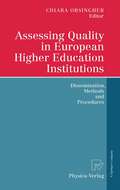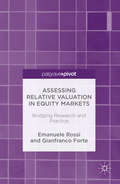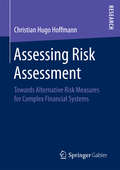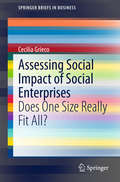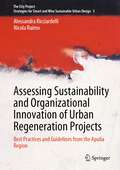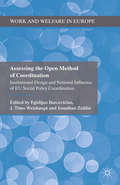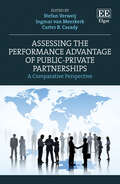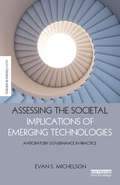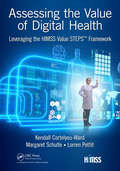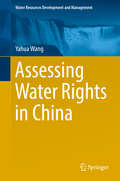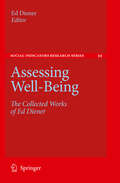- Table View
- List View
Assessing Quality in European Higher Education Institutions: Dissemination, Methods and Procedures
by Chiara OrsingherEuropean higher education institutions are facing in these last years a number of relevant political and social changes that have asked for more transparency, accountability, comparability and legitimacy of degrees. In light of these new challenges, the great majority of universities have responded by implementing quality assurance processes, either through evaluation or through accreditation. This book collects the evaluation and accreditation experiences gathered by higher education institutions in Finland, France, Germany, Italy, the Netherlands, Spain, the United Kingdom and Sweden. It provides a synthetic picture of the present state of quality assurance practices in Europe and offers a few lessons for a future European dimension of quality assurance.
Assessing Relative Valuation in Equity Markets: Bridging Research and Practice
by Emanuele Rossi Gianfranco ForteThis book addresses the gap between the widespread use of stock market multiples in valuation practice and the frontiers of research on multiples. The book's approach is twofold: the authors first analyse the performance of multiples metrics in predicting the market price of a set of liquid and highly traded US stocks. The authors then employ these results to test profitable stock purchasing strategies employed in order to 'beat the market'. The results presented widen our understanding of the “market performances” of the valuation tools practitioners utilise in their everyday work. The evidence is of interest to researchers and equity analysts, who wish to analyse the circumstances in which valuation errors using multiples are more frequent and when market multiples become ineffective in estimating market prices.
Assessing Risk Assessment: Towards Alternative Risk Measures for Complex Financial Systems
by Christian Hugo HoffmannChristian Hugo Hoffmann undermines the citadel of risk assessment and management, arguing that classical probability theory is not an adequate foundation for modeling systemic and extreme risk in complex financial systems. He proposes a new class of models which focus on the knowledge dimension by precisely describing market participants’ own positions and their propensity to react to outside changes. The author closes his thesis by a synthetical reflection on methods and elaborates on the meaning of decision-making competency in a risk management context in banking. By choosing this poly-dimensional approach, the purpose of his work is to explore shortcomings of risk management approaches of financial institutions and to point out how they might be overcome.
Assessing Social Impact of Social Enterprises: Does One Size Really Fit All? (SpringerBriefs in Business #0)
by Cecilia GriecoThis book explores the diversity of Social Impact Assessment (SIA) models and outlines a self-assessment on models to support social entrepreneurs. The chapters trace the concept and origins of social entrepreneurship and elicits current implementation of SIA models by social enterprises. The comprehensive review of over seventy five SIA models will be especially useful for social entrepreneurs and researchers.
Assessing Sustainability and Organizational Innovation of Urban Regeneration Projects: Best Practices and Guidelines from the Apulia Region (The City Project #3)
by Alessandra Ricciardelli Nicola RaimoThis book offers the first comprehensive report on the topic of organizational innovation and sustainability of urban regeneration from the public manager's perspective. Starting from a rich set of case studies on urban regeneration from the region of Apulia, in Italy, it develops a framework for measuring their sustainability performance. It proposes the use of indicators related to different aspects of the urban regeneration process, including the participations of stakeholders; land use and buildings; economy and jobs; transportation; environmental pollution; energy use; waste management; as well as open spaces and wildlife. This book offers extensive information to graduate students and researchers, and to authorities, developers, investors and stakeholders alike, involved in the design, planning and management, and sustainable development of urban spaces. It is expected to foster a better understanding of the level of organizational innovation and sustainability of urban regeneration projects and the role of governing bodies in their implementation.
Assessing the Benefits and Costs of ITS: Making the Business Case for ITS Investments (Transportation Research, Economics and Policy)
by David Gillen David LevinsonThe 17 chapters in this book, which evolved from a conference on measuring the contributions of ITS sponsored by the California Department of Transportation in February 2002, examine the costs and benefits of ITS in an economic and business policy context. Section 1 examines the broad theme of how and what ITS contributes to the economy and how one makes a business case for ITS. Section 2 includes three chapters on ITS applications in mass transit. Section 3 explores ITS applications in the automobile/highway system. Section 4 considers integrative issues including how ITS is perceived and how it can be positioned to improve surface transportation. This volume will be especially useful to researchers and policy makers working in transportation, transportation engineering, and the economic analysis of transportation systems.
Assessing the Demographic Impact of Development Projects: Conceptual, methodological and policy issues (Routledge Revivals)
by A. S. OberaiFirst published in 1992, Assessing the Demographic Impact of Development Projects based on studies in developing countries focuses on conceptual, methodological and policy issues related to development projects. It considers whether demographic effects can be assessed and why development planners should be interested in such an assessment. A.S. Oberai examines the extent to which economic and social changes generated by specific development interventions have influenced demographic behaviour in a particular context. He suggests how desired effects can be enhanced and undesired effects minimized by policy makers and planners in developing countries in order to deal with problems of population growth and its distribution. The major shortcomings of existing methodologies are identified, and the author indicates the future direction which research might take in order to be more scientifically valid and useful to policy makers. This book is a must read for scholars and researchers of development studies, political economy and labour economy.
Assessing the Demographic Impact of Development Projects: Conceptual, methodological and policy issues (Routledge Revivals)
by A. S. OberaiFirst published in 1992, Assessing the Demographic Impact of Development Projects based on studies in developing countries focuses on conceptual, methodological and policy issues related to development projects. It considers whether demographic effects can be assessed and why development planners should be interested in such an assessment. A.S. Oberai examines the extent to which economic and social changes generated by specific development interventions have influenced demographic behaviour in a particular context. He suggests how desired effects can be enhanced and undesired effects minimized by policy makers and planners in developing countries in order to deal with problems of population growth and its distribution. The major shortcomings of existing methodologies are identified, and the author indicates the future direction which research might take in order to be more scientifically valid and useful to policy makers. This book is a must read for scholars and researchers of development studies, political economy and labour economy.
Assessing the Different Roles of Marketing Theory and Practice in the Jaws of Economic Uncertainty: Proceedings of the 2004 Academy of Marketing Science (AMS) Annual Conference (Developments in Marketing Science: Proceedings of the Academy of Marketing Science)
by Harlan E. SpottsThis volume includes the full proceedings from the 2004 Academy of Marketing Science (AMS) Annual Conference held in Vancouver, Canada, entitled Assessing the Different Roles of Marketing Theory and Practice in the Jaws of Economic Uncertainty. It include papers aimed to create awareness of the issues, trends, and advances associated with current marketing theories and practices. Founded in 1971, the Academy of Marketing Science is an international organization dedicated to promoting timely explorations of phenomena related to the science of marketing in theory, research, and practice. Among its services to members and the community at large, the Academy offers conferences, congresses and symposia that attract delegates from around the world. Presentations from these events are published in this Proceedings series, which offers a comprehensive archive of volumes reflecting the evolution of the field. Volumes deliver cutting-edge research and insights, complementing the Academy’s flagship journals, the Journal of the Academy of Marketing Science (JAMS) and AMS Review. Volumes are edited by leading scholars and practitioners across a wide range of subject areas in marketing science.
Assessing the Economic Impact of Tourism: A Computable General Equilibrium Modelling Approach
by Samuel Meng Mahinda SiriwardanaThis book employs a computable general equilibrium (CGE) model – a widely used economic model which uses actual data to provide economic analysis and policy assessment – and applies it to economic data on Singapore’s tourism industry. The authors set out to demonstrate how a novice modeller can acquire the necessary skills and knowledge to successfully apply general equilibrium models to tourism studies. The chapters explain how to build a computable general equilibrium model for tourism, how to conduct simulation and, most importantly, how to analyse modelling results. This applied study acts as a modelling book at both introductory and intermediate levels, specifically targeting students and researchers who are interested in and wish to learn computable general equilibrium modelling. The authors offer insightful analysis of Singapore’s tourism industry and provide both students and researchers with a guide on how to apply general equilibrium models to actual economic data and draw accurate conclusions.
Assessing the Economic Impact of Tourism: A Computable General Equilibrium Modelling Approach
by Samuel Meng Mahinda SiriwardanaThis book employs a computable general equilibrium (CGE) model – a widely used economic model which uses actual data to provide economic analysis and policy assessment – and applies it to economic data on Singapore’s tourism industry. The authors set out to demonstrate how a novice modeller can acquire the necessary skills and knowledge to successfully apply general equilibrium models to tourism studies. The chapters explain how to build a computable general equilibrium model for tourism, how to conduct simulation and, most importantly, how to analyse modelling results. This applied study acts as a modelling book at both introductory and intermediate levels, specifically targeting students and researchers who are interested in and wish to learn computable general equilibrium modelling. The authors offer insightful analysis of Singapore’s tourism industry and provide both students and researchers with a guide on how to apply general equilibrium models to actual economic data and draw accurate conclusions.
Assessing the Economic Value of Venture Capital Contracts: An Option Pricing Approach (ebs-Forschung, Schriftenreihe der EUROPEAN BUSINESS SCHOOL Schloß Reichartshausen #78)
by Jil Caroline OnimusDr. Jil Caroline Onimus identifies the baskets of real options embedded in model venture capital contracts as published by the National Venture Capital Association (NVCA) and shows how they can be priced in interaction using Least Squares Monte Carlo simulation.
Assessing the Extent of China's Marketization (The Chinese Trade and Industry Series)
by Xiaoxi LiChina is indisputably one of the most dynamic economic regions in the world; however the character, nature and extent of its market economy status remains in question. This book provides an empirical analysis of many aspects of the developing market economy including: government reform; the marketization of enterprises; land transactions; capital transactions and finance; the market determination of wage rates; the development of intermediary organizations; and the improvement in the economy's legal framework. China's economic growth has also brought conflict with both the EU and the US. This book examines the contentious debates such as: the extent of renminbi convertibility; the independence of the financial sector; the freedom of labour in wage-rate bargaining; the extent of foreign investment; the extent of government ownership of enterprises; the protection of property rights; and the development of company law and of corporate governance.
Assessing the Extent of China's Marketization (The Chinese Trade and Industry Series)
by Xiaoxi LiChina is indisputably one of the most dynamic economic regions in the world; however the character, nature and extent of its market economy status remains in question. This book provides an empirical analysis of many aspects of the developing market economy including: government reform; the marketization of enterprises; land transactions; capital transactions and finance; the market determination of wage rates; the development of intermediary organizations; and the improvement in the economy's legal framework. China's economic growth has also brought conflict with both the EU and the US. This book examines the contentious debates such as: the extent of renminbi convertibility; the independence of the financial sector; the freedom of labour in wage-rate bargaining; the extent of foreign investment; the extent of government ownership of enterprises; the protection of property rights; and the development of company law and of corporate governance.
Assessing the Impact of Foreign Aid: Value for Money and Aid for Trade
by Viktor Jakupec Max KellyAssessing the Impact of Foreign Aid: Value for Money and Aid for Trade provides updated information on how to improve foreign aid programs, exploring the concept and practice of impact assessment within the sometimes-unproblematic approaches advocated in current literature of value for money and aid for trade. Contributors from multi-lateral agencies and NGOs discuss the changing patterns of Official Development Assistance and their effects on impact assessment, providing theoretical, political, structural, methodological, and practical frameworks, discussions, and a theory-practice nexus. With twin foci of economics and policy this book raises the potential for making sophisticated and coherent decisions on aid allocation to developing countries. Addresses the impact of aid for trade and value for money, rather than its implementationDiscusses the changing patterns of Official Development Assistance and their effects on impact assessment, providing theoretical, political, structural, methodological, and practical frameworks, discussions, and a theory-practice nexusAssesses the effects and implications of the value for money and aid for trade agendasHighlights economic issues
Assessing the Impacts of Climate Change on Natural Resource Systems
by Norman J. Rosenberg Kenneth D. FrederickThis volume characterizes the current state of natural science and socioeconomic modeling of the impacts of climate change and current climate variability on forests, grasslands, and water. It identifies what can be done currently with impact assessments and suggests how to undertake such assessments. Impediments to linking biophysical and socioeconomic models into integrated assessments for policy purposes are identified, and recommendations for future research activities to improve the state of the art and remove these impediments to model integration are provided. This book is for natural and social scientists with an interest in the impacts of climate change on terrestrial and aquatic ecosystems and their socioeconomic impacts, and policy makers interested in understanding the status of current assessment capabilities and in identifying priority areas for future research.
Assessing the Open Method of Coordination: Institutional Design and National Influence of EU Social Policy Coordination (Work and Welfare in Europe)
by Egidijus Barcevicius J. Timo Weishaupt Jonathan ZeitlinBased on the findings of a large-scale, comparative research project, this volume systematically assesses the institutional design and national influence of the Open Method of Coordination in Social Inclusion and Social Protection (pensions and health/long-term care), at the European Union level and in ten EU Member States.
Assessing the Performance Advantage of Public-Private Partnerships: A Comparative Perspective
This timely book questions the premise that Public-Private Partnerships (PPPs) have a performance advantage over traditionally procured projects, an assumption that motivates policymakers worldwide to enter into such contracts. Taking stock of novel research comparing the differences in performance between PPP and traditionally procured infrastructure projects and services, the chapters in this book thoughtfully scrutinise this supposed advantage.Adopting a quasi-experimental design, the book advances the evidence base on the performance advantage of PPPs. Insightful contributions from renowned scholars undertake an in-depth investigation of three key performance dimensions: cost, time, and service quality. Broad in scope, studies span countries in Asia, Europe, and South America, as well as a diverse range of policy sectors, including transport, healthcare, road safety, education, and sporting facilities. This comprehensive assessment produces several conclusions, but ultimately determines that evidence for a cost performance advantage remains mixed, while PPPs are proven to clearly outperform traditional alternatives in terms of time and service quality.Empirical in focus and spanning multiple policy sectors, this incisive book will be an invaluable resource not only for PPP scholars, but also for researchers and practitioners involved in public administration, public management and policy, and infrastructure planning and delivery worldwide.
Assessing the Societal Implications of Emerging Technologies: Anticipatory governance in practice (The Earthscan Science in Society Series)
by Evan S. MichelsonA growing problem of interest in the field of science and technology policy is that the next generation of innovations is arriving at an accelerating rate, and the governance system is struggling to catch up. Current approaches and institutions for effective technology assessment are ill suited and poorly designed to proactively address the multidimensional, interconnected societal impacts of science and technology advancements that are already taking place and expected to continue over the course of the 21st century. This book offers tangible insights into the strategies deployed by well-known, high-profile organizations involved in anticipating the various societal and policy implications of nanotechnology and synthetic biology. It focuses predominantly on an examination of the practices adopted by the often-cited and uniquely positioned Project on Emerging Nanotechnologies in the United States, as well as being informed by comparisons with a range of institutions also interested in embedding forward-looking perspectives in their respective area of innovation. The book lays out one of the first actionable roadmaps that other interested stakeholders can follow when working toward institutionalizing anticipatory governance practices throughout the policymaking process.
Assessing the Societal Implications of Emerging Technologies: Anticipatory governance in practice (The Earthscan Science in Society Series)
by Evan S. MichelsonA growing problem of interest in the field of science and technology policy is that the next generation of innovations is arriving at an accelerating rate, and the governance system is struggling to catch up. Current approaches and institutions for effective technology assessment are ill suited and poorly designed to proactively address the multidimensional, interconnected societal impacts of science and technology advancements that are already taking place and expected to continue over the course of the 21st century. This book offers tangible insights into the strategies deployed by well-known, high-profile organizations involved in anticipating the various societal and policy implications of nanotechnology and synthetic biology. It focuses predominantly on an examination of the practices adopted by the often-cited and uniquely positioned Project on Emerging Nanotechnologies in the United States, as well as being informed by comparisons with a range of institutions also interested in embedding forward-looking perspectives in their respective area of innovation. The book lays out one of the first actionable roadmaps that other interested stakeholders can follow when working toward institutionalizing anticipatory governance practices throughout the policymaking process.
Assessing the Value of Digital Health: Leveraging the HIMSS Value STEPS™ Framework (HIMSS Book Series)
by Kendall Cortelyou-Ward Margaret Schulte Lorren PettitHIMSS set out to develop a dynamic framework by which to easily catalogue the varied beneficial evidences of digital health. From this effort, HIMSS introduced to the market the HIMSS Value STEPS™ framework. This book will leverage the HIMSS Value STEPS™ model to identify and define the expressions of value the use of health IT systems can yield per the following domains: Satisfaction, Treatment/Clinical, Electronic Secure Data, Patient Engagement and Population Health, and Savings. Using this framework, HIMSS has developed a collection of over 2,000 cases reflecting the value that hospitals, health systems and other providers have experienced following implementation of their electronic health record and/or other IT-related applications. The more than 17,000 value statements that have been extracted from the 2,000+ case articles have been classified within 85 Standard Value Standard (SVS) within the five STEPS domains. The book will describe the STEPS model to demonstrate the impact of health IT in healthcare organizations, and the quality of care and overall financial and operational performance improvements that have been achieved.
Assessing the Value of Digital Health: Leveraging the HIMSS Value STEPS™ Framework (HIMSS Book Series)
by Kendall Cortelyou-Ward Margaret Schulte Lorren PettitHIMSS set out to develop a dynamic framework by which to easily catalogue the varied beneficial evidences of digital health. From this effort, HIMSS introduced to the market the HIMSS Value STEPS™ framework. This book will leverage the HIMSS Value STEPS™ model to identify and define the expressions of value the use of health IT systems can yield per the following domains: Satisfaction, Treatment/Clinical, Electronic Secure Data, Patient Engagement and Population Health, and Savings. Using this framework, HIMSS has developed a collection of over 2,000 cases reflecting the value that hospitals, health systems and other providers have experienced following implementation of their electronic health record and/or other IT-related applications. The more than 17,000 value statements that have been extracted from the 2,000+ case articles have been classified within 85 Standard Value Standard (SVS) within the five STEPS domains. The book will describe the STEPS model to demonstrate the impact of health IT in healthcare organizations, and the quality of care and overall financial and operational performance improvements that have been achieved.
Assessing Vendors: A Hands-On Guide to Assessing Infosec and IT Vendors
by Josh MoreAssessing vendors is a tricky process. Large and regulated organizations are forced to demonstrate due diligence in vendor assessment, but often do not know how to do this. This results in a great deal of busywork being required by both the vendors and the organizations. Smaller organizations don't know what to look for and, as a result, often wind up selecting based on price instead of value. This results in service failures and vendors that just milk their customers for as long as they can. Assessing Vendors shows you how to walk the line between under- and over-assessing, so decisions can be made on sufficient data without wasting time, digging too deeply, or making decisions too quickly. This hands-on guide will show you how to use an iterative approach to vendor analysis, so you can rapidly filter out the vendors that are clear failures and then select likely winners. It will then show you how to do progressively deeper dives into the likely winners so you can select a preferred vendor. Finally, you will learn how to negotiate with your preferred vendor to get reasonable prices and services. Provides an iterative approach to vendor assessment, showing you how to make decisions on sufficient data without wasting time Includes checklists to help you navigate the decision-making process, while considering all the important factors needed to make a sound decision Helps you understand and evaluate vendors based on key concepts such as performance criteria, functional testing, production, and priceProvides an iterative approach to vendor assessment, showing you how to make decisions on sufficient data without wasting timeIncludes checklists to help you navigate the decision-making process, while considering all the important factors needed to make a sound decisionHelps you understand and evaluate vendors based on key concepts such as performance criteria, functional testing, production, and price
Assessing Water Rights in China (Water Resources Development and Management)
by Yahua WangThis book presents a model for describing the hierarchical concept of China’s water rights structure, one which takes into account pioneering theories on natural resources and environmental institutional economics. It highlights the basic theory of water rights, with a view to helping Chinese policymakers acquire a deeper understanding of water rights and the need for a reform program in the long-term development of water-poor China. To do so, it draws on three main sources: Cheung SNS’s “Economic Explanation”, Douglas C. North’s “New Economic History” and Ray Huang’s “Macro History”.The book makes two essential contributions: it elaborates the hierarchical water governance structure in China, which originated in the Qin Dynasty that unified the country 2000 years ago and has been employed without interruption ever since; further, it constructs a choice model for water governance structures and advances the logic of making structural choices with minimum transaction costs under constraint conditions, while also explaining the inherent nature of China’s choice for the hierarchical structure from the perspectives of management cost and cooperation cost. As such, the book enriches and builds on the theories of the “water governance” school represented by Karl Marx, Karl Wittfogel and Ray Huang, laying the foundation for the further study of water rights theory in contemporary China.
Assessing Well-Being: The Collected Works of Ed Diener (Social Indicators Research Series #39)
by Ed DienerThe Sandvik, Diener, and Seidlitz (1993) paper is another that has received widespread attention because it documented the fact that self-report well-being scales correlate with a number of other methods of measuring the same concepts, such as with reports by knowledgeable “informants” (family and friends), expe- ence sampling measurement, and the memory for good versus bad life events. A single factor was found to underlie measures using different methods, and a n- ber of different well-being self-report measures were found to correlate with the non-self-report measures. Thus, although the self-report measures of well-being are imperfect, and can be in uenced by response artifacts, they have substantial validity as shown by their correlations with measurements based on alternative methods. Whereas the Pavot and Diener article reviewed the Satisfaction with Life Scale, the Lucas, Diener, and Larsen (2003) paper reviews various approaches to assessing positive emotions. As we wrote in the chapter in this volume in which we present new measures, we do not consider any of the existing measures of positive affect to be entirely acceptable for measuring subjective well-being in the affect area, and that is why we have created and validated a new measure.
